Accepted Scientific Name: Opuntia engelmannii subs. aciculata (Griffiths) U.Guzmán & Mandujano
Cactaceae Syst. Init. 16: 18 (11 Oct. 2003). (first published in U.Guzmán et al., Catálogo Cact. Mex.: 179 [May 2003])
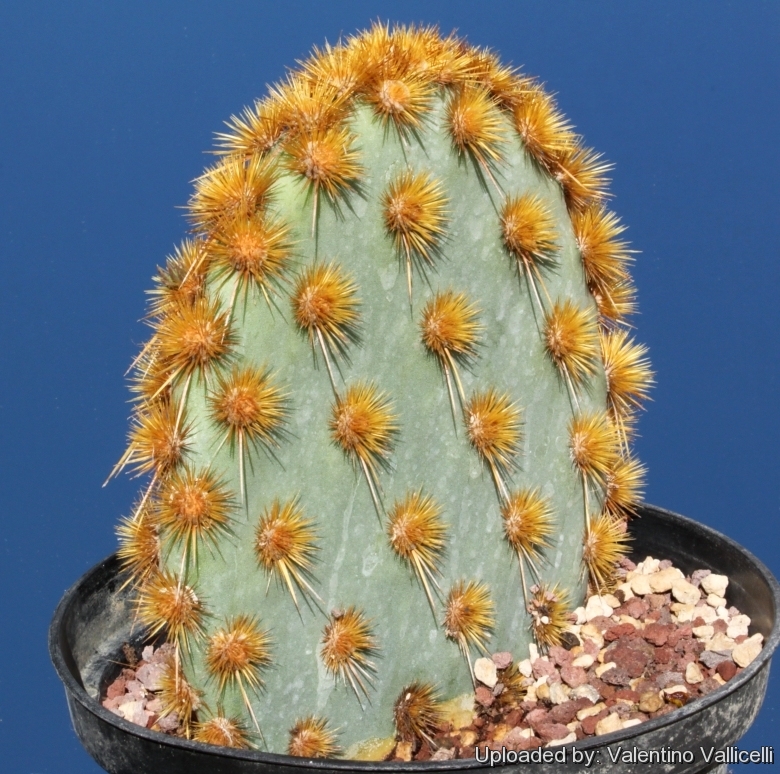
Opuntia lindheimeri var. aciculata (Opuntia engelmannii subs. aciculata) Photo by: Valentino Vallicelli
Origin and Habitat: South-western USA (Texas ), north-western Mexico.
Habitat & Ecology: It grows in dry hills mainly on stony outcrops, often in small colonies usually to the exclusion of other plants.
Synonyms:
See all synonyms of Opuntia engelmannii
back
Accepted name in llifle Database:Opuntia engelmannii Salm-Dyck ex Engelm.Cact. Hort. Dyck. (1849) Boston J. Nat. Hist. 6(2): 207 (-208). 1850 [Jan 1850] et: Cact. Hort. Dyck. (1849). 1849: 235. 1850 [Apr 1850]Synonymy: 21
Accepted name in llifle Database:Opuntia engelmannii subs. aciculata (Griffiths) U.Guzmán & MandujanoCactaceae Syst. Init. 16: 18 (11 Oct. 2003). (first published in U.Guzmán et al., Catálogo Cact. Mex.: 179 [May 2003])Synonymy: 5
Accepted name in llifle Database:Opuntia engelmannii var. cuija GriffithsNew Mexico Agric. Exp. Sta. Bull. 60: 44, pl. 2. 1906Synonymy: 4
Accepted name in llifle Database:Opuntia engelmannii var. dulcis (Engelm.) J.M.Coult. ex K.Schum.Gesamtbeschr. Kakt. 725 725 1898.Synonymy: 2
Accepted name in llifle Database:Opuntia engelmannii var. flavescens (Peebles) L.D.BensonCacti Ariz. 58 58 1950.Synonymy: 2
Accepted name in llifle Database:Opuntia engelmannii var. flavispina (L.D.Benson) B.D.Parfitt & PinkavaMadroño 35: 348. 1988Synonymy: 2
Accepted name in llifle Database:Opuntia engelmannii var. flexospina (Griffiths) B.D.Parfitt & PinkavaMadroño 35(4): 348 348 1988Synonymy: 3
Accepted name in llifle Database:Opuntia engelmannii subs. lindheimeri (Engelm.) U.Guzmán & MandujanoCactaceae Syst. Init. 16: 18 (11 Oct. 2003), first published in U.Guzmán et al., Catálogo Cact. Mex.: 179 [May 2003]Synonymy: 6
Accepted name in llifle Database:Opuntia engelmannii var. linguiformis (Griffiths) B.D.Parfitt & PinkavaMadroño 35(4): 347. 1989 [1988 publ. 1989]Synonymy: 3
Cultivars
(1):
back
Common Names include:
ENGLISH: Nopal
Description: Opuntia engelmannii subs. aciculataSN|19915]]SN|19915]] is a flattened-padded succulent, forming large, hemispherical, bushy clumps up to 60-90 (or more tall) cm tall and 100-300 cm wide. The lower branches decumbent and sending up erect branches.
Stem: Segments obovate or partly rounded at apex, faded and glaucous, dull grey-green more or less glaucous. They measure 10-20 cm. in length.
Leaves: Acicular, awl-shapedup to 7 mm long, ephemeral.
Areoles: Large, widely separated, round. Often spineless.
Glochids: Numerous, 3-12 mm long, acicular, slender, spreading, forming a dense cluster, golden yellow to dark red, thin, long, from all part of the areoles, persisting for several years.
Spines: 1-3 , often absent, reflexed, of a yellowish/toasted colour with a brownish base, up to 3(-5,5) cm in length. Often folded and seemingly decidous.
Flower: Golden yellow, diameter 8-10 cm. Several sources report the flowers as being 'yellow'. But the plant in cultivation usually has bright red-orange flowers, and sometimes the centre is greenish. Petals broad rounded or retuse, filaments yellowish. Stigma dull yellowish with 8-10 green lobes.
Blooming season: Early summer.
Fruit: Pear-shaped, covered with fine spines and glochids, purple.
More...Subspecies, varieties, forms and cultivars of plants belonging to the Opuntia engelmannii group
 Opuntia engelmannii Salm-Dyck ex Engelm.: (var. engelmannii) Spines chalky white, yellow when wetted, with dark red-brown extreme bases.
Opuntia engelmannii Salm-Dyck ex Engelm.: (var. engelmannii) Spines chalky white, yellow when wetted, with dark red-brown extreme bases. Opuntia engelmannii subs. aciculata (Griffiths) U.Guzmán & Mandujano: has numerous, 3-12 mm long, acicular, spreading, glochids forming a dense cluster, golden yellow from all part of the areoles, persisting for several years. Distribution: South-western USA (Texas ), north-western Mexico.
Opuntia engelmannii subs. aciculata (Griffiths) U.Guzmán & Mandujano: has numerous, 3-12 mm long, acicular, spreading, glochids forming a dense cluster, golden yellow from all part of the areoles, persisting for several years. Distribution: South-western USA (Texas ), north-western Mexico.- Opuntia engelmannii var. cuija Griffiths: endemic to Mexico, in Guanajuato, Hidalgo, San Luis Potos
 Opuntia engelmannii var. cyclodes Engelm. & J.M.Bigelow
Opuntia engelmannii var. cyclodes Engelm. & J.M.Bigelow- Opuntia engelmannii var. dulcis (Engelm.) J.M.Coult. ex K.Schum.
- Opuntia engelmannii var. flavescens (Peebles) L.D.Benson
- Opuntia engelmannii var. flavispina (L.D.Benson) B.D.Parfitt & Pinkava: Spines arching downward near bases. South-central Arizona.
- Opuntia engelmannii var. flexospina (Griffiths) B.D.Parfitt & Pinkava: Spines strongly deflexed. South Texas.
- Opuntia engelmannii subs. lindheimeri (Engelm.) U.Guzmán & Mandujano: Stem segments with spines straight or slightly curving, spreading. It is endemic to U.S. in Louisiana, New Mexico, Oklahoma, Texas.
 Opuntia engelmannii subs. lindheimeri cv. Gomei: the segments are often scalloped, wavy at margins and more or leas raised at areoles. Origin: near the coast of southern texas, USA.
Opuntia engelmannii subs. lindheimeri cv. Gomei: the segments are often scalloped, wavy at margins and more or leas raised at areoles. Origin: near the coast of southern texas, USA.- Opuntia engelmannii var. linguiformis (Griffiths) B.D.Parfitt & Pinkava: Stem segments becoming very elongate, 2+ times longer than wide, lanceolate to linear-lanceolate, often falcate. Distribution: Texas.
Bibliography: Major references and further lectures
1) Anderson, E. F. “The cactus family” 2001.
2) Hunt, D., Taylor, N. and Charles, G. “The New Cactus Lexicon.” dh Books, Milborne Port, UK. 2006
3) N. L. Britton, J. N. Rose: “The Cactaceae. Descriptions and Illustrations of Plants of the Cactus Family.” Vol I, The Carnegie Institution of Washington, Washington 1919
4) Joseph Nelson Rose “Studies of Mexican and Central American Plants” Volume 1, U.S. Government Printing Office, 1909
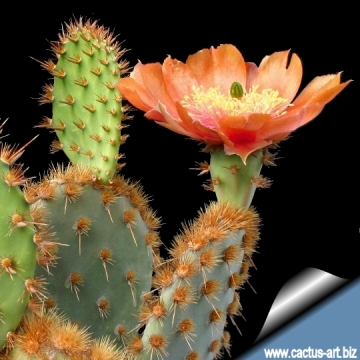 Opuntia lindheimeri var. aciculata (Opuntia engelmannii subs. aciculata) Photo by: Cactus Art
Opuntia lindheimeri var. aciculata (Opuntia engelmannii subs. aciculata) Photo by: Cactus Art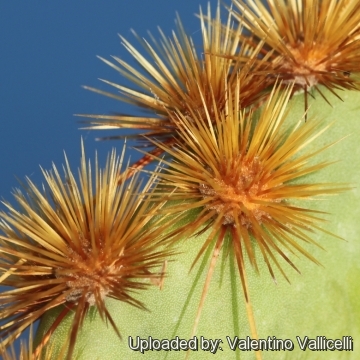 Opuntia lindheimeri var. aciculata (Opuntia engelmannii subs. aciculata) Photo by: Valentino Vallicelli
Opuntia lindheimeri var. aciculata (Opuntia engelmannii subs. aciculata) Photo by: Valentino Vallicelli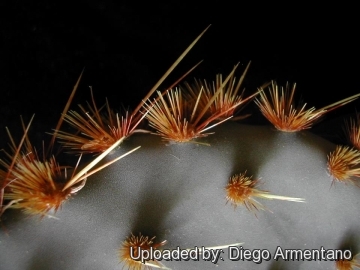 Opuntia lindheimeri var. aciculata (Opuntia engelmannii subs. aciculata) Photo by: Diego Armentano
Opuntia lindheimeri var. aciculata (Opuntia engelmannii subs. aciculata) Photo by: Diego Armentano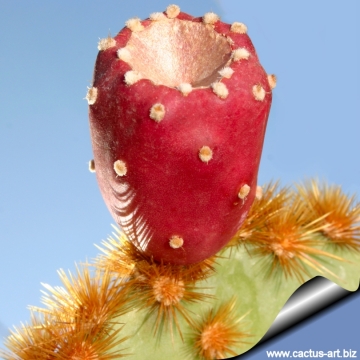 Opuntia lindheimeri var. aciculata (Opuntia engelmannii subs. aciculata) Photo by: Cactus Art
Opuntia lindheimeri var. aciculata (Opuntia engelmannii subs. aciculata) Photo by: Cactus Art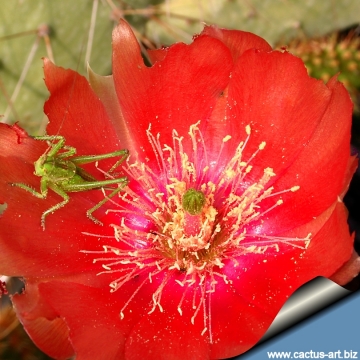 Opuntia lindheimeri var. aciculata (Opuntia engelmannii subs. aciculata) Photo by: Cactus Art
Opuntia lindheimeri var. aciculata (Opuntia engelmannii subs. aciculata) Photo by: Cactus Art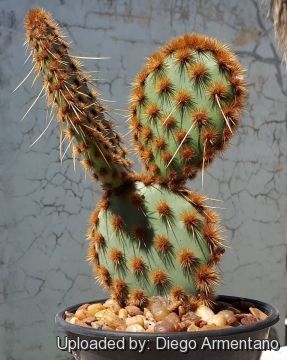 Opuntia lindheimeri var. aciculata (Opuntia engelmannii subs. aciculata) Photo by: Diego Armentano
Opuntia lindheimeri var. aciculata (Opuntia engelmannii subs. aciculata) Photo by: Diego Armentano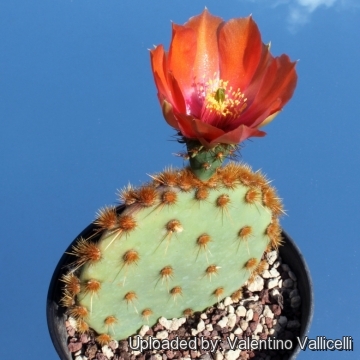 Opuntia lindheimeri var. aciculata (Opuntia engelmannii subs. aciculata) Photo by: Valentino Vallicelli
Opuntia lindheimeri var. aciculata (Opuntia engelmannii subs. aciculata) Photo by: Valentino Vallicelli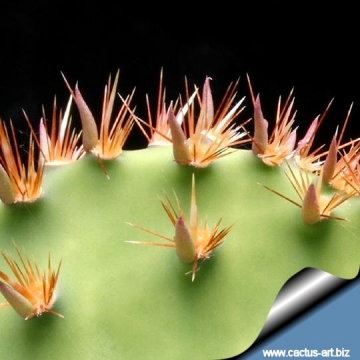 Opuntia lindheimeri var. aciculata (Opuntia engelmannii subs. aciculata) Photo by: Cactus Art
Opuntia lindheimeri var. aciculata (Opuntia engelmannii subs. aciculata) Photo by: Cactus ArtCultivation and Propagation: It is a low maintenance plant that tolerate considerable neglect and will naturalize, it is drought-tolerant; and suitable for xeriscaping. Easy to cultivate outdoor in dry, sandy or gravely, well-drained soils. May be grown in clay soils as long as drainage is good and soils do not remain wet, it is very adaptable both in acid, neutral and basic (alkaline) soils, but prefers a pH in the range 6 to 7.5. No serious insect or disease problems.
Watering Needs: Outdoors little or no water once established, in the green house irrigate regularly from March to october, keep fairly dry in winter, tolerate dry condition but suffer if exposed to prolonged and severe drought. A position at the base of a south-facing wall or somewhere that can be protected from winter rain is best for this plant, but is however resistant to moisture and rain.
Sun Exposure: Full sun (only), in semi shaded position wont produce many flowers.
Frost hardiness: They are reasonably cold hardy , tolerating temperatures down to -5° to -12° C (USDA: 8-10) depending on clone, they are also quite tolerant of winter wet. (In good drained soils)
Traditional uses: The fruit are edible and the tender joints can be coked as a vegetable. In medicine the plant are used to treat dyspepsia, mumps, swelling and in veterinary it is used to treat bruises. The joints are also a good food for cattle (after burning of spines)
Propagation: Propagated by cuttings of leaf pads at any time in the growing season. (Allow cut surface to callus over before planting).
More...
Your Photos
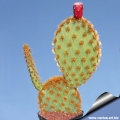
by Cactus Art

by Cactus Art

by Valentino Vallicelli
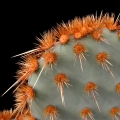
by Valentino Vallicelli






















